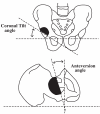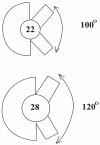Basic science considerations in primary total hip replacement arthroplasty
- PMID: 20582240
- PMCID: PMC2892068
- DOI: 10.2174/1874325001004010169
Basic science considerations in primary total hip replacement arthroplasty
Abstract
Total Hip Replacement is one of the most common operations performed in the developed world today. An increasingly ageing population means that the numbers of people undergoing this operation is set to rise. There are a numerous number of prosthesis on the market and it is often difficult to choose between them. It is therefore necessary to have a good understanding of the basic scientific principles in Total Hip Replacement and the evidence base underpinning them. This paper reviews the relevant anatomical and biomechanical principles in THA. It goes on to elaborate on the structural properties of materials used in modern implants and looks at the evidence base for different types of fixation including cemented and uncemented components. Modern bearing surfaces are discussed in addition to the scientific basis of various surface engineering modifications in THA prostheses. The basic science considerations in component alignment and abductor tension are also discussed. A brief discussion on modular and custom designs of THR is also included. This article reviews basic science concepts and the rationale underpinning the use of the femoral and acetabular component in total hip replacement.
Keywords: Hip replacement; arthroplasty..
Figures




Similar articles
-
The European school of total hip arthroplasty and 35 years of total hip arthroplasty in the Czech Republic.Acta Chir Orthop Traumatol Cech. 2005;72(1):57-76. Acta Chir Orthop Traumatol Cech. 2005. PMID: 15860155
-
[Influence of the Type of Hip-Component Fixation and Age of Patients on Mid-Term Revision Rate of Total Hip Replacement].Acta Chir Orthop Traumatol Cech. 2018;85(1):46-53. Acta Chir Orthop Traumatol Cech. 2018. PMID: 30257769 Slovak.
-
[A comparative study on short-term effectiveness between cemented and uncemented total hip arthroplasty for osteonecrosis of femoral head after renal transplantation].Zhongguo Xiu Fu Chong Jian Wai Ke Za Zhi. 2013 Dec;27(12):1409-13. Zhongguo Xiu Fu Chong Jian Wai Ke Za Zhi. 2013. PMID: 24640354 Chinese.
-
[Arthroplasty for intracapsular fractures of the femoral neck. Current concept review].Acta Chir Orthop Traumatol Cech. 2012;79(6):484-92. Acta Chir Orthop Traumatol Cech. 2012. PMID: 23286679 Review. Czech.
-
Systematic review of the outcome of cemented versus uncemented total hip arthroplasty following pelvic irradiation.Musculoskelet Surg. 2019 Dec;103(3):221-230. doi: 10.1007/s12306-019-00597-z. Epub 2019 Apr 1. Musculoskelet Surg. 2019. PMID: 30937859
Cited by
-
Radiological Comparison of Canal Fill between Collared and Non-Collared Femoral Stems: A Two-Year Follow-Up after Total Hip Arthroplasty.J Imaging. 2024 Apr 25;10(5):99. doi: 10.3390/jimaging10050099. J Imaging. 2024. PMID: 38786553 Free PMC article.
-
Total hip arthroplasty using a combined anterior and posterior approach via a lateral incision in patients with ankylosed hips.Can J Surg. 2013 Oct;56(5):332-40. doi: 10.1503/cjs.000812. Can J Surg. 2013. PMID: 24067518 Free PMC article.
-
High Accuracy of Restoration of the Individual Hip Anatomy Using Custom-Made Prostheses in Total Hip Arthroplasty.J Clin Med. 2025 Mar 20;14(6):2115. doi: 10.3390/jcm14062115. J Clin Med. 2025. PMID: 40142923 Free PMC article.
-
The Relative Merits of Cemented and Uncemented Prostheses in Total Hip Arthroplasty.Indian J Orthop. 2017 Jul-Aug;51(4):377-385. doi: 10.4103/ortho.IJOrtho_405_16. Indian J Orthop. 2017. PMID: 28790466 Free PMC article.
-
The migration pattern of the Charnley femoral stem: a five-year follow-up RSA study in a well-functioning patient group.J Orthop Traumatol. 2012 Sep;13(3):137-43. doi: 10.1007/s10195-012-0187-x. Epub 2012 May 11. J Orthop Traumatol. 2012. PMID: 22576838 Free PMC article. Clinical Trial.
References
-
- Hospital Episode System Data. 1-1-1996. London, Department of Health. Ref Type: Report.
-
- Arthritis. 1992. London OHE, Office of Health Economics. Ref Type: Report.
-
- Radin EL. Biomechanics of the human hip. Clin Orthop Relat Res. 1980:28–34. - PubMed
-
- Noble PC, Alexander JW, Lindahl LJ, et al. The anatomic basis of femoral component design. Clin Orthop Relat Res. 1988:148–65. - PubMed
LinkOut - more resources
Full Text Sources
